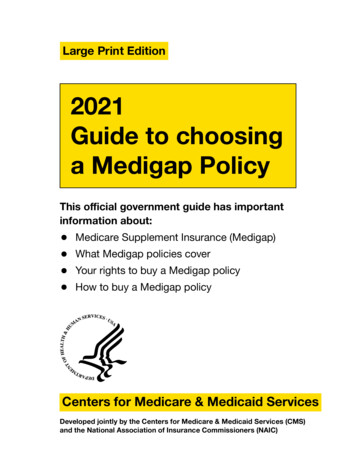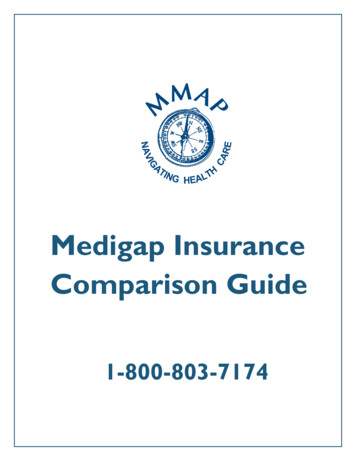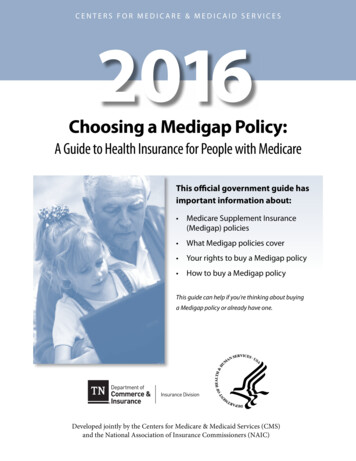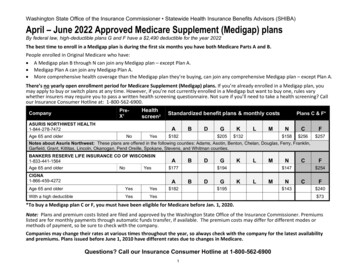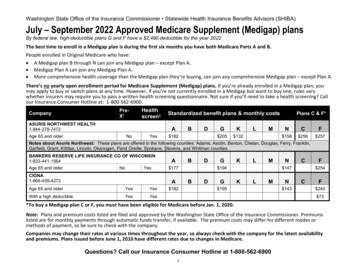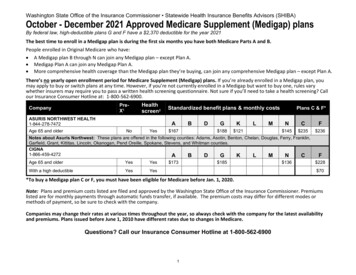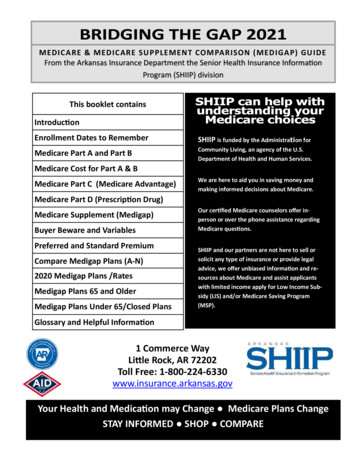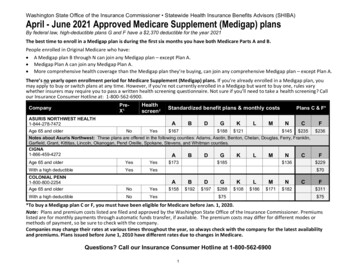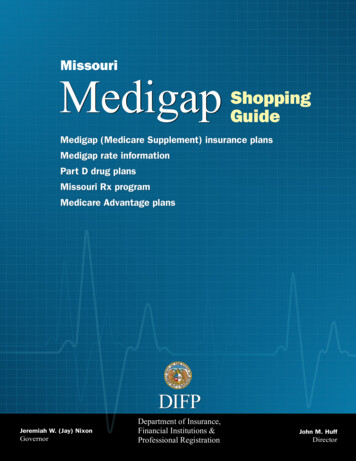
Transcription
CENTERS FOR MEDICARE & MEDICAID SERVICES2022Choosing a Medigap Policy:A Guide to Health Insurance for People with MedicareThis official government guide hasimportant information about: Medicare Supplement Insurance(Medigap) What Medigap policies cover Your rights to buy a Medigap policy How to buy a Medigap policyDeveloped jointly by the Centers for Medicare & Medicaid Services (CMS)and the National Association of Insurance Commissioners (NAIC)
Who should read this guide?If you're thinking about buying a Medicare Supplement Insurance (Medigap) policy oryou already have one, this guide can help you understand how it works.Important information about this guideThe information in this guide describes the Medicare Program at the time thisguide was printed. Changes may occur after printing. Visit Medicare.gov, or call1‑800‑MEDICARE (1‑800‑633‑4227) to get the most current information. TTY userscan call 1‑877‑486‑2048.“2022 Choosing a Medigap Policy: A Guide to Health Insurance for People with Medi‑care” isn’t a legal document. Official Medicare Program legal guidance iscontained in the relevant statutes, regulations, and rulings.This product was produced at U.S. taxpayer expense.
Table of ContentsSection 1: Medicare Basics35What’s Medicare? . . . . . . . . . . . . . . . . . . . . . . . . . . . . . . . . . . . . . . . . . . . . . . . . . . . . 6The different parts of Medicare . . . . . . . . . . . . . . . . . . . . . . . . . . . . . . . . . . . . . . . . . 6Your Medicare coverage options . . . . . . . . . . . . . . . . . . . . . . . . . . . . . . . . . . . . . . . . 7Medicare and the Health Insurance Marketplace . . . . . . . . . . . . . . . . . . . . . . . . . 8Find more information about Medicare . . . . . . . . . . . . . . . . . . . . . . . . . . . . . . . . . 8Section 2: Medigap Basics9What’s a Medigap policy? . . . . . . . . . . . . . . . . . . . . . . . . . . . . . . . . . . . . . . . . . . . . . . 9What Medigap policies cover . . . . . . . . . . . . . . . . . . . . . . . . . . . . . . . . . . . . . . . . . . 10What Medigap policies don’t cover . . . . . . . . . . . . . . . . . . . . . . . . . . . . . . . . . . . . . 12Types of coverage that are NOT Medigap policies . . . . . . . . . . . . . . . . . . . . . . . . 12What types of Medigap policies can insurance companies sell? . . . . . . . . . . . . . 12What do I need to know if I want to buy a Medigap policy? . . . . . . . . . . . . . . . . 13When's the best time to buy a Medigap policy? . . . . . . . . . . . . . . . . . . . . . . . . . . 14Why is it important to buy a Medigap policy when I’m first eligible? . . . . . . . . 16How do insurance companies set prices for Medigap policies? . . . . . . . . . . . . . 17What this pricing may mean for you . . . . . . . . . . . . . . . . . . . . . . . . . . . . . . . . . . . . . 18Comparing Medigap costs . . . . . . . . . . . . . . . . . . . . . . . . . . . . . . . . . . . . . . . . . . . . 19What’s Medicare SELECT? . . . . . . . . . . . . . . . . . . . . . . . . . . . . . . . . . . . . . . . . . . . 20How does Medigap help pay my Medicare Part B costs? . . . . . . . . . . . . . . . . . . . 20Section 3: Your Right to Buy a Medigap Policy21What are guaranteed issue rights? . . . . . . . . . . . . . . . . . . . . . . . . . . . . . . . . . . . . . 21When do I have guaranteed issue rights? . . . . . . . . . . . . . . . . . . . . . . . . . . . . . . . . 21Can I buy a Medigap policy if I lose my health coverage? . . . . . . . . . . . . . . . . . . 24Section 4: Steps to Buying a Medigap Policy25Step-by-step guide to buying a Medigap policy . . . . . . . . . . . . . . . . . . . . . . . . . . . 25Section 5: If You Already Have a Medigap Policy31Switching Medigap policies . . . . . . . . . . . . . . . . . . . . . . . . . . . . . . . . . . . . . . . . . . 32Losing Medigap coverage . . . . . . . . . . . . . . . . . . . . . . . . . . . . . . . . . . . . . . . . . . . . . 36Medigap policies and Medicare drug coverage . . . . . . . . . . . . . . . . . . . . . . . . . . . 36
4Table of ContentsSection 6: Medigap Policies for People with a Disability or ESRD39Information for people under 65 . . . . . . . . . . . . . . . . . . . . . . . . . . . . . . . . . . . . . . 39Section 7: Medigap Coverage in Massachusetts, Minnesota, and Wisconsin41Massachusetts benefits . . . . . . . . . . . . . . . . . . . . . . . . . . . . . . . . . . . . . . . . . . . . . . . 42Minnesota benefits . . . . . . . . . . . . . . . . . . . . . . . . . . . . . . . . . . . . . . . . . . . . . . . . . . 43Wisconsin benefits . . . . . . . . . . . . . . . . . . . . . . . . . . . . . . . . . . . . . . . . . . . . . . . . . . 44Section 8: For More Information45Where to get more information . . . . . . . . . . . . . . . . . . . . . . . . . . . . . . . . . . . . . . . 45How to get help with Medicare and Medigap questions . . . . . . . . . . . . . . . . . . . 46State Health Insurance Assistance Program (SHIP) and StateInsurance Department . . . . . . . . . . . . . . . . . . . . . . . . . . . . . . . . . . . . . . . . . . . . . . 47Section 9: Definitions49
51SECTIONWords in blueare defined onpages 49–50.Medicare Basics
6Section 1: Medicare BasicsWhat’s Medicare?Medicare is health insurance for people 65 or older, certain people under 65 withdisabilities, and people of any age with End-Stage Renal Disease (ESRD) (permanentkidney failure requiring dialysis or a kidney transplant).The different parts of MedicareThe different parts of Medicare help cover specific services.Part A (Hospital Insurance)Helps cover: Inpatient care in hospitals Skilled nursing facility care Hospice care Home health carePart B (Medical Insurance)Helps cover: Services from doctors and other health care providers Outpatient care Home health care Durable medical equipment (like wheelchairs, walkers,hospital beds, and other equipment) Many preventive services (like screenings, shots or vaccines,and yearly “Wellness” visits)Part D (Drug coverage)Helps cover: Cost of prescription drugs (including many recommendedshots or vaccines)Plans that offer Medicare drug coverage are run by privateinsurance companies that follow rules set by Medicare.
Section 1: Medicare Basics7Your Medicare coverage optionsWhen you first enroll in Medicare and during certain times of the year, you can choose howyou get your Medicare coverage. There are 2 main ways to get Medicare.Original Medicare Includes Medicare Part A (HospitalInsurance) and Part B (Medical Insurance). You can join a separate Medicare drug planto get Medicare drug coverage (Part D). You can use any doctor or hospital thattakes Medicare, anywhere in the U.S. To help pay your out-of-pocket costsin Original Medicare (like your 20%coinsurance), you can also shop for andbuy supplemental coverage.Medicare Advantage(also known as Part C) A Medicare-approved plan from a privatecompany that offers an alternative toOriginal Medicare for your health and drugcoverage. These "bundled" plans includePart A, Part B, and usually Part D. In most cases, you’ll need to use doctorswho are in the plan’s network. Plans may have lower out-of-pocket coststhan Original Medicare. Plans may offer some extra benefits thatOriginal Medicare doesn't cover - likevision, hearing, and dental services.Part APart BPart AYou can add:Part BPart DMost plans include:You can also add:SupplementalcoverageThis includes MedicareSupplement Insurance(Medigap). Or, you can usecoverage from a formeremployer or union, or Medicaid.Part DSome extra benefitsSome plans also include:Lower out-of-pocket-costs
8Section 1: Medicare BasicsMedicare and the Health Insurance Marketplace If you have coverage through an individual Marketplace plan (not through anemployer), you should enroll in Medicare during your Initial Enrollment Periodto avoid the risk of a delay in Medicare coverage and the possibility of a Medicarelate enrollment penalty. For most people, their Initial Enrollment period is the7-month period that starts 3 months before the month they turn 65, includes themonth they turn 65, and ends 3 months after the month they turn 65.You can keep your Marketplace plan without penalty until your Medicare coveragestarts. Once you’re considered eligible for premium-free Part A, you won’t qualifyfor help paying your Marketplace plan premiums or other costs. If you continue toget help paying your Marketplace plan premium after you have Medicare, you mayhave to pay back some or all of the help you got when you file your taxes.Visit HealthCare.gov to find your state’s Marketplace, or learn how to end yourMarketplace financial help or plan to avoid a gap in coverage. You can also call theMarketplace Call Center at 1-800-318-2596. TTY users can call 1-855-889-4325.Note: Medicare isn’t part of the Marketplace. The Marketplace doesn’t offerMedicare Supplement Insurance (Medigap) policies, Medicare Advantage Plans, orMedicare drug coverage (Part D).Find more information about MedicareTo learn more about Medicare: Visit Medicare.gov. Look at your “Medicare & You” handbook. Get free, personalized counseling from your State Health Insurance AssistanceProgram (SHIP). (See pages 47– 48.) Call 1-800-MEDICARE (1-800-633-4227). TTY users can call 1-877-486-2048. Find and compare health and drug plans at Medicare.gov/plan-compare.Health Insurance Marketplace is a registered service mark of the U.S. Department ofHealth & Human Services.
92SECTIONMedigap BasicsWhat’s a Medigap policy?A Medigap policy is an insurance policy that helps fill "gaps" in OriginalMedicare and is sold by private companies. Original Medicare pays formuch, but not all, of the cost for covered health care services and supplies.Medigap policies are sold by private companies, and can help pay for someof the costs that Original Medicare doesn't, like copayments, coinsurance,and deductibles.Some Medigap policies also cover certain benefits Original Medicare doesn’tcover, like emergency foreign travel expenses. Medigap policies don’t coveryour share of the costs under other types of health coverage, includingMedicare Advantage Plans, stand-alone Medicare drug plans,employer/union group health coverage, Medicaid, or TRICARE.If you have Original Medicare and a Medigap policy, Medicare will payits share of the Medicare-approved amounts for covered health care costs.Then, your Medigap policy pays its share. Medicare doesn't pay any of thecosts of buying a Medigap policy.Words in blueare defined onpages 49–50.A Medigap policy is different from a Medicare Advantage Plan becausethose plans are another way to get your Part A and Part B benefits, while aMedigap policy only helps pay for the costs that Original Medicare doesn'tcover. Insurance companies generally can’t sell you a Medigap policy if youhave coverage through a Medicare Advantage Plan or Medicaid.All Medigap policies must follow federal and state laws designed to protectyou, and policies must be clearly identified as “Medicare SupplementInsurance.” Medigap policies are standardized, and in most states arenamed by letters, Plans A–N. Each standardized Medigap policy underthe same plan letter must offer the same basic benefits, no matter whichinsurance company sells it.Cost is usually the only difference between Medigap policies with thesame plan letter sold by different insurance companies.
10Section 2: Medigap BasicsWhat Medigap policies coverThe chart on page 11 gives you a quick look at the standardized Medigapplans available. For more information to help find a policy that works for you, lans. If you need help comparingand choosing a policy, call your State Health Insurance Assistance Program (SHIP)for help. See pages 47–48 for your state’s phone number. Every insurance company selling Medigap policies must offer Plan A. If theywant to offer policies in addition to Plan A, they must also offer either Plan C orPlan F to individuals who aren't new to Medicare and either Plan D or Plan G toindividuals who are new to Medicare. Not all types of Medigap policies may beavailable in your state. Plans D and G with coverage starting on or after June 1, 2010, have differentbenefits than Plans D or G bought before June 1, 2010. Plans E, H, I, and J are no longer sold, but if you already have one, you cangenerally keep it. Since January 1, 2020, Medigap plans sold to people new to Medicare aren't allowedto cover the Part B deductible. Because of this, Plans C and F are no longeravailable to people new to Medicare on or after January 1, 2020.– If you already have either of these two plans (or the high deductible versionof Plan F) or you were covered by one of these plans before January 1, 2020,you'll be able to keep your plan. If you were eligible for Medicare beforeJanuary 1, 2020, but not yet enrolled, you may be able to buy one of theseplans.– For this situation, people new to Medicare are people who turned 65 onor after January 1, 2020, and people who get Medicare Part A (HospitalInsurance) on or after January 1, 2020.In Massachusetts, Minnesota, and Wisconsin, Medigap policies are standardized in adifferent way. (See pages 42–44.) In some states, you may be able to buy another typeof Medigap policy called Medicare SELECT. Medicare SELECT are standardized plansthat may require you to see certain providers and may cost less than other Medigapplans. (See page 20.)
Section 2: Medigap Basics11This chart shows basic information about the different benefits that Medigap plans cover.If a percentage appears, the Medigap plan covers that percentage of the benefit, and youmust pay the rest. If a box is blank, the plan doesn't cover that benefit.Medicare Supplement Insurance (Medigap) PlansBenefitsMedicare Part Acoinsurance and hospitalcosts (up to an additional365 days after Medicarebenefits are used)Medicare Part Bcoinsurance or copaymentBlood (first 3 pints)Part A hospice carecoinsurance or copaymentSkilled nursing facility carecoinsurancePart A deductiblePart B deductiblePart B excess chargeForeign travel emergency(up to plan limits)ABCDF*G*KLMN100% 100% 100% 100% 100% 100% 100% 100% 100% 100%100% 100% 100% 100% 100% 100%50%75%100% 100% 100% 100% 100% 100%100% 100% 100% 100% 100% 100%50%50%75%75%100% 100%***100% 100%100% 100%100% 100% 100% 100%50%75%100% 100%100% 100% 100% 100% 100%100%100%100% 100%80% 80% 80% 80%50%75%50%100%80%80%Out-ofpocket limitin 2022** 6,620 3,310* Plans F and G also offer a high-deductible plan in some states (Plan F isn't available to people new toMedicare on or after January 1, 2020.) If you get the high-deductible option, you must pay for Medicarecovered costs (coinsurance, copayments, and deductibles) up to the deductible amount of 2,490 in 2022before your policy pays anything, and you must also pay a separate deductible ( 250 per year) for foreigntravel emergency services.**Plans K and L show how much they'll pay for approved services before you meet your out-of-pocketyearly limit and your Part B deductible ( 233 in 2022). After you meet these amounts, the plan will pay100% of your costs for approved services for the rest of the calendar year.*** Plan N pays 100% of the Part B coinsurance, except for a copayment of up to 20 for some office visitsand up to a 50 copayment for emergency room visits that don’t result in an inpatient admission.
12Section 2: Medigap BasicsWhat Medigap policies don’t coverGenerally, Medigap policies don’t cover: long-term care (like non-skilled care you get in a nursing home) vision or dental services hearing aids eyeglasses private‑duty nursingTypes of coverage that are NOT Medigap policies Medicare Advantage Plans (also known as Part C)Medicare drug plan (Part D)MedicaidEmployer or union plans, including the Federal Employees HealthBenefits Program (FEHBP)TRICAREVeterans’ benefitsLong-term care insurance policiesIndian Health Service, Tribal, and Urban Indian Health plansQualified Health Plans sold in the Health Insurance Marketplace What types of Medigap policies can insurancecompanies sell?In most cases, Medigap insurance companies can sell you only a standardizedMedigap policy. All Medigap policies must have specific benefits, so you cancompare them easily. If you live in Massachusetts, Minnesota, or Wisconsin, seepages 42– 44.Insurance companies that sell Medigap policies don’t have to offer every Medigapplan. Each insurance company decides which Medigap plans it wants to sell, althoughfederal and state laws might affect which ones they can offer.In some cases, an insurance company must sell you a Medigap policy if you wantone, even if you have health problems. You're guaranteed the right to buy a Medigappolicy during certain times: When you’re in your Medigap Open Enrollment Period. (See pages 14 –15.) If you have a guaranteed issue right. (See pages 21–23.)You may be able to buy a Medigap policy at other times, but the insurance companycan deny you a Medigap policy based on your health. Also, in some cases, it may beillegal for the insurance company to sell you a Medigap policy (like if you alreadyhave Medicaid or a Medicare Advantage Plan).
Section 2: Medigap Basics13What do I need to know if I want to buy a Medigap policy? You must have Medicare Part A (Hospital Insurance) and Medicare Part B(Medical Insurance). If you have a Medicare Advantage Plan but are planning to return to OriginalMedicare, you can apply for a Medigap policy before your coverage ends. TheMedigap insurance company can sell it to you as long as you’re leaving theMedicare Advantage Plan. Ask that the new Medigap policy start when yourMedicare Advantage Plan enrollment ends, so you’ll have continuous coverage. You pay the private insurance company a premium for your Medigap policy inaddition to the monthly Part B premium you pay to Medicare. A Medigap policy only covers one person. If you and your spouse both wantMedigap coverage, you each will have to buy separate Medigap policies. When you have your Medigap Open Enrollment Period, you can buy a Medigappolicy from any insurance company that’s licensed in your state. Any new Medigap policy issued since 1992 is guaranteed renewable even if youhave health problems. This means the insurance company can’t cancel yourMedigap policy as long as you stay enrolled and pay the premium. Different insurance companies may charge different premiums for the same exactMedigap plan type. As you shop for a policy, be sure you’re comparing policiesunder the same plan type (for example, compare Plan A from one company withPlan A from another company). Some states may have laws that may give you additional protections. Although some Medigap policies sold in the past covered prescription drugs,Medigap policies sold after January 1, 2006, aren’t allowed to include prescriptiondrug coverage. If you want drug coverage, you can join a Medicare drug planoffered by private companies approved by Medicare. (See pages 6–7.) To learnabout Medicare drug coverage, visit Medicare.gov, or call 1-800-MEDICARE(1-800-633-4227). TTY users can call 1-877-486-2048.
14Section 2: Medigap BasicsWhen's the best time to buy a Medigap policy?The best time to buy a Medigap policy is during your Medigap Open EnrollmentPeriod. This period lasts for 6 months and begins on the first day of the monthyou’re both 65 or older and enrolled in Medicare Part B. Some states haveadditional Open Enrollment Periods including those for people under 65. Ifyou’re under 65 and have Medicare because of a disability or End-Stage RenalDisease (ESRD), you might not be able to buy the Medigap policy you want, orany Medigap policy, until you turn 65. (See page 39 for more information.)During the Medigap Open Enrollment Period, an insurance company can’t usemedical underwriting to decide whether to accept your application. This meansthe insurance company can’t do any of these because of your health problems: Refuse to sell you any Medigap policy it offers Charge you more for a Medigap policy than they charge someone with nohealth problems Make you wait for coverage to start (except as explained below)While the insurance company can’t make you wait for your coverage to start, it maybe able to make you wait for coverage related to a pre-existing condition.A pre-existing condition is a health problem you have before the date a newinsurance policy starts. In some cases, the Medigap insurance company canrefuse to cover your out-of-pocket costs for these pre-existing health problemsfor up to 6 months. This is called a “pre-existing condition waiting period.”After 6 months, the Medigap policy will cover the pre-existing condition.Coverage for a pre-existing condition can only be excluded if the condition wastreated or diagnosed within 6 months before your Medigap policy coverage starts.This is called the “look-back period.” Remember, for Medicare‑covered services,Original Medicare will still cover the condition, even if the Medigap policy won’t,but you’re responsible for the Medicare coinsurance or copayment.
Section 2: Medigap BasicsWhen's the best time to buy a Medigap policy? (continued)Creditable coverageIt’s possible to avoid or shorten your waiting period for a pre-existingcondition if: You buy a Medigap policy during your 6-month Medigap OpenEnrollment Period. You’re replacing certain kinds of health coverage that counts as “creditablecoverage.”Prior creditable coverage is generally any other health coverage you recentlyhad before applying for a Medigap policy. If you’ve had at least 6 months ofcontinuous prior creditable coverage, the Medigap insurance company can’tmake you wait before it covers your pre-existing conditions.There are many types of health coverage that may count as creditablecoverage for Medigap policies, but they’ll only count if you didn’t have abreak in coverage for more than 63 days.Your Medigap insurance company can tell you if your previous coverage willcount as creditable coverage for this purpose. You can also call your StateHealth Insurance Assistance Program (SHIP). (See pages 47– 48.)If you buy a Medigap policy when you have a guaranteed issue right (alsocalled “Medigap protection”), the insurance company can’t use a pre‑existingcondition waiting period. See pages 21–23 for more information aboutguaranteed issue rights.15
16Section 2: Medigap BasicsWhy is it important to buy a Medigap policy whenI’m first eligible?During your Medigap Open Enrollment Period, you have the right to buy anyMedigap policy offered in your state. In addition, you generally will get betterprices and more choices among policies. If you apply for Medigap coverageafter your Open Enrollment Period, there’s no guarantee that an insurancecompany will sell you a Medigap policy if you don’t meet the medicalunderwriting requirements, unless you’re eligible for guaranteed issue rights(Medigap protections) because of one of the situations listed on pages 22–23.It’s also important to understand that your Medigap rights may depend on whenyou choose to enroll in Medicare Part B. If you’re 65 or older, your MedigapOpen Enrollment Period begins when you enroll in Part B, and it can’t bechanged or repeated. After your Medigap Open Enrollment Period ends, youmay be denied a Medigap policy or charged more for a Medigap policy due topast or present health problems.In most cases, it makes sense to enroll in Part B and buy a Medigap policywhen you’re first eligible for Medicare, because you might otherwise have topay a Part B late enrollment penalty and might miss your 6-month MedigapOpen Enrollment Period. However, there are exceptions if you have employercoverage.Employer coverageIf you have group health coverage through an employer or union, because eitheryou or your spouse is currently working, you may want to wait to enroll inPart B. Benefits based on current employment often provide coverage similarto Part B, so you wouldn’t want to pay for Part B before you need it, and yourMedigap Open Enrollment Period might expire before a Medigap policy wouldbe useful. When the employer coverage ends, you’ll get a chance to enroll inPart B without a late enrollment penalty, which means your Medigap OpenEnrollment Period will start when you’re ready to take advantage of it. If you oryour spouse is still working and you have coverage through an employer, contactyour employer or union benefits administrator to find out how your insuranceworks with Medicare. See page 24 for more information.
Section 2: Medigap BasicsHow do insurance companies set prices for Medigappolicies?Each insurance company decides how it’ll set the price, or premium, for itsMedigap policies. The way they set the price affects how much you pay nowand in the future. Each Medigap policy can be priced or "rated" in one ofthree ways:1. Community-rated (also called “no-age-rated”)2. Issue-age-rated (also called “entry-age-rated”)3. Attained-age-ratedEach of these ways of pricing Medigap policies is described in the chart onthe next page. The examples show how your age affects your premiums,and why it’s important to look at how much the Medigap policy will costyou now and in the future. The amounts in the examples aren’t actual costs.Other factors like where you live, medical underwriting, and discounts canalso affect the amount of your premium.17
18Section 2: Medigap BasicsHow do insurance companies set prices for Medigap policies? (continued)Type ofpricingHow it’spricedWhat this pricing maymean for youExamplesCommunityrated(also called“no-agerated”)Generally thesame premiumis charged toeveryone whohas the Medigappolicy, regardlessof age or gender.Your premium isn’t based onyour age. Premiums may goup because of inflation andother factors but not becauseof your age.Mr. Smith is 65. He buys a Medigappolicy and pays a 165 monthlypremium.Issue-agerated (alsocalled “entryage-rated”)The premium isbased on the ageyou are whenyou buy (are“issued”) theMedigap policy.Premiums are lower for people Mr. Han is 65. He buys a Medigapwho buy at a younger age and policy and pays a 145 monthlywon’t change as you get older. premium.Premiums may go up becauseMrs. Wright is 72. She buys the sameof inflation and other factorsMedigap policy as Mr. Han. Since shebut not because of your age.is older when she buys it, her monthlypremium is 175.Attained-ageratedThe premium isbased on yourcurrent age(the age you’ve“attained”), soyour premiumgoes up as youget older.Premiums are low foryounger buyers but go upas you get older. They maybe the least expensive atfirst, but they can eventuallybecome the most expensive.Premiums may also go upbecause of inflation andother factors.Mrs. Perez is 72. She buys the sameMedigap policy as Mr. Smith. She alsopays a 165 monthly premium.Mrs. Anderson is 65. She buys aMedigap policy and pays a 120monthly premium. Her premium willgo up each year: At 66, her premium goes up to 126. At 67, her premium goes up to 132.Mr. Dodd is 72. He buys the sameMedigap policy as Mrs. Anderson.He pays a 165 monthly premium.His premium is higher than Mrs.Anderson’s because it’s based on hiscurrent age. Mr. Dodd’s premium willgo up each year: At 73, his premium goes up to 171. At 74, his premium goes up to 177.
Section 2: Medigap Basics19Comparing Medigap costsAs discussed on the previous pages, the cost of Medigap policies can varywidely. There can be big differences in the premiums that differentinsurance companies charge for exactly the same coverage. As you shopfor a Medigap policy, be sure to compare Medigap plan types with the sameletter, and consider the type of pricing each insurance company uses. (Seepages 17–18.) For example, compare Plan G from one company with Plan Gfrom another company. Although this guide can’t give actual costs of Medigappolicies, you can get this information by calling insurance companies or yourState Health Insurance Assistance Program (SHIP). (See pages 47– 48.)You can also find out which insurance companies sell Medigap policies inyour area by visiting The cost of your Medigap policy may also depend on whether the insurancecompany: Offers discounts (like discounts for women, non-smokers, or marriedpeople; discounts for paying yearly; discounts for paying your premiumsusing electronic funds transfer; or discounts for multiple policies). Uses medical underwriting, or applies a different premium when you don’thave a guaranteed issue right or aren’t in a Medigap Open EnrollmentPeriod. Sells Medicare SELECT policies that may require you to use certainproviders. If you buy this type of Medigap policy, your premium may beless. (See page 20.) Offers a “high-deductible option” for Plans F or G. If you buy Plans F or Gwith a high-deductible option, you must pay the first 2,490 of deductibles,copayments, and coinsurance (in 2022) for covered services not paid byMedicare before the Medigap policy pays anything. You must also pay aseparate deductible ( 250 per year) for foreign travel emergency services.
20Section 2: Medigap BasicsWhat’s Medicare SELECT?Medicare SELECT is a type of Medigap policy sold in some states thatrequires you to use hospitals and, in some cases, doctors within its networkto be eligible for full insurance benefits (except in an emergency). MedicareSELECT can be offered as any of the standardized Medigap plans. (See page11.) These policies generally cost less than other Medigap policies. However,if you don’t use a Medicare SELECT hospital or doctor for non-emergencyservices, you’ll have to pay some or all of what Medicare doesn’t pay. Medicarewill pay its share of approved charges no matter which hospital or doctor youchoose.How does Medigap help pay my Medicare Part B costs?In most Medigap policies, you agree to have the Medigap insurancecompany get your Part B claim information directly from Medicare. Then,the Medigap insurance company
Medicare Advantage Plans, stand‑alone Medicare drug plans, employer/union group health coverage, Medicaid, or TRICARE. If you have Original Medicare and a Medigap policy, Medicare will pay . its share of the . Medicare‑approved amounts for covered health care costs. Then, your Medigap policy pays its share. Medicare doesn't pay any of the
